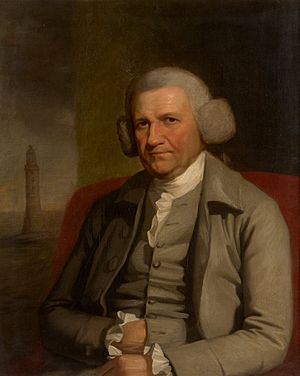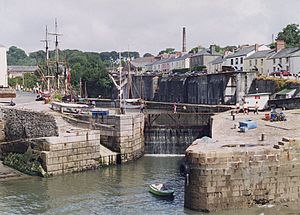John Smeaton facts for kids
Quick facts for kids
John Smeaton
|
|
|---|---|

Smeaton, with the Eddystone Lighthouse in the background
|
|
| Born | 8 June 1724 Austhorpe, West Riding of Yorkshire, England
|
| Died | 28 October 1792 (aged 68) Austhorpe, West Riding of Yorkshire, England
|
| Resting place | St Mary's Church, Whitkirk |
| Occupation | Civil engineer |
| Awards | Copley Medal (1759) |
John Smeaton (8 June 1724 – 28 October 1792) was a famous British engineer. He designed many important structures. These included bridges, canals, harbors, and lighthouses. He was also good at mechanical engineering and physics.
Smeaton was the first person to call himself a "civil engineer." Many people call him the "father of civil engineering". He found new ways to use special cement. This cement could set underwater. He used pebbles and crushed bricks in it. Smeaton was part of a group called the Lunar Society.
Contents
Early Life and Discoveries
John Smeaton was born in Austhorpe, Leeds, England. He went to Leeds Grammar School. After school, he worked for his father's law firm. But he soon left to become a maker of scientific tools. He worked with Henry Hindley. Smeaton invented a pyrometer. This tool helped study how materials expand when heated.
In 1753, Smeaton became a member of the Royal Society. This is a famous group for scientists. In 1759, he won the Copley Medal. He won it for his studies on how waterwheels and windmills work. His research helped make water power more efficient. This was important for the Industrial Revolution.
Smeaton also studied how air pressure affects moving objects. His ideas helped create the "Smeaton Coefficient." This was an important step in understanding how things fly.
The Smeaton Coefficient
In 1759, John Smeaton wrote a paper. It was about the power of water and wind to turn mills. In this paper, he developed ideas that led to the Smeaton coefficient. This coefficient was used in the lift equation by the Wright brothers. They used it when they were designing their first airplanes.
The equation looked like this:
Here,  is the lift (how much an object can fly).
is the lift (how much an object can fly).  is the Smeaton coefficient.
is the Smeaton coefficient.  is the speed.
is the speed.  is the area of the wing.
is the area of the wing.  is the lift coefficient.
is the lift coefficient.
The Wright brothers later found that the value Smeaton used for k was not quite right. They used wind tunnels to find a better value.
Amazing Civil Engineering Projects
Smeaton played a big part in developing modern cement. He figured out what was needed for cement to set underwater. This led to the invention of Portland cement. Thanks to Smeaton, concrete became a very important building material again.
The Royal Society asked Smeaton to design the third Eddystone Lighthouse. He built it between 1755 and 1759. He was the first to use "hydraulic lime". This is a special type of mortar that hardens underwater. He also used a new method of joining granite blocks. He used dovetailed blocks.
His lighthouse was used until 1877. The rocks under it started to wear away. The lighthouse was taken apart and partly rebuilt. You can still see it today at Plymouth Hoe. It is known as Smeaton's Tower.
Smeaton decided to focus on civil engineering. He worked on many projects. Here are some of them:
- The Calder and Hebble Navigation (1758–70)
- Coldstream Bridge over the River Tweed (1763–66)
- Improvements to the River Lee Navigation (1765–70)
- Smeaton's Pier in St Ives, Cornwall (1767–70)
- Perth Bridge over the River Tay in Perth (1766–71)
- Ripon Canal (1766–1773)
- Smeaton's Viaduct near Newark (1768–70)
- The Forth and Clyde Canal (1768–77)
- Banff harbor (1770–75)
- Aberdeen bridge (1775–80)
- Peterhead harbor (1775–1881)
- Ramsgate harbor works (1776–92)
- Hexham Bridge (1777–90)
- The Birmingham and Fazeley Canal (1782–89)
- Charlestown harbor in Cornwall (1792)
Smeaton was the first expert witness in an English court. He was asked to share his engineering knowledge. This happened in 1782 for a case about a harbor silting up.
Mechanical Engineering Skills
Smeaton also used his skills as a mechanical engineer. In 1761, he designed a water engine for the Royal Botanic Gardens at Kew. In 1767, he built a watermill at Alston. Some people say he invented the cast-iron axle for waterwheels.
In 1782, he built the Chimney Mill in Newcastle upon Tyne. This was the first windmill in Britain with five sails. He also made improvements to Thomas Newcomen's atmospheric engine. He built a very efficient and powerful one in Cornwall in 1775.
In 1789, Smeaton improved a diving bell design. He used a pump to keep fresh air inside. This allowed people to work underwater. He also explained the differences between overshot and undershot water wheels.
Smeaton's Lasting Legacy
Smeaton died after having a stroke. He was buried in the church at Whitkirk, West Yorkshire. His daughters put up a memorial for him and his wife.
Engineers highly respect Smeaton. He helped start the Smeatonian Society of Civil Engineers in 1771. He created the term civil engineers. This was to show they were different from military engineers. This society was a step towards the Institution of Civil Engineers.
The "Smeaton's coefficient" was named after him. It describes how pressure changes with speed for objects moving in air. The Wright brothers used his ideas to build the first successful airplanes.
Between 1860 and 1894, Smeaton’s Eddystone lighthouse was shown on the back of the old British penny coin.
Smeaton is one of six civil engineers honored in a stained glass window. This window is in Westminster Abbey. A special stone remembering Smeaton was placed there in 1994.

John Smeaton Academy is a school in Leeds named after him. The Mathematics and Technology Department at the University of Plymouth is also in a building named after him. A viaduct in Leeds, opened in 2008, also carries his name.
In 2003, Smeaton was named one of the top 10 technological innovators. This was in a book called Human Accomplishment. The band Kaiser Chiefs mentions him in their song "I Predict a Riot".
Works by John Smeaton
- A Narrative Of The Building And A Description Of The Construction Of The Edystone Lighthouse With Stone. London: H. Hughs. 1791.
- "An Account of Some Improvements of the Mariners Compass", Philosophical Transactions of the Royal Society of London Series I, vol 46 (1749), p.513-517
- "A Letter from Mr. J. Smeaton to Mr. John Ellicott, F. R. S. concerning Some Improvements Made by Himself in the Air-Pump", Philosophical Transactions of the Royal Society of London Series I, vol 47 (1751), p.415-428
- "An Engine for Raising Water by Fire", Philosophical Transactions of the Royal Society of London Series, vol 47 (1751), p.436-438
- "A Description of a New Tackle or Combination of Pullies", Philosophical Transactions of the Royal Society of London Series I, vol 47 (1751), p.494-497
- "An Account of Some Experiments upon a Machine for Measuring the Way of a Ship at Sea", Philosophical Transactions of the Royal Society of London Series I, vol 48 (1753), p.532-546
- "Description of a New Pyrometer, with a Table of Experiments Made Therewith", Philosophical Transactions of the Royal Society of London Series I, vol 48 (1753), p.598-613
- "An Experimental Enquiry concerning the Natural Powers of Water and Wind to Turn Mills, and Other Machines, Depending on a Circular Motion", Philosophical Transactions of the Royal Society of London Series I, vol 51 (1759), p.100-174
- "A Discourse concerning the Menstrual Parallax", Philosophical Transactions of the Royal Society of London Series I, vol 58 (1768), p.156-169
- "Description of a New Method of Observing the Heavenly Bodies out of the Meridian", Philosophical Transactions of the Royal Society of London Series I, vol 58 (1768), p.170-173
- "Description of a New Hygrometer", Philosophical Transactions of the Royal Society of London Series I, vol 61 (1771), p.198-211
- "An Experimental Examination of the Quantity and Proportion of Mechanic Power Necessary to be Employed in Giving Different Degrees of Velocity to Heavy Bodies from a State of Rest", Philosophical Transactions of the Royal Society of London Series I, vol 66 (1776), p.450-475
- "New Fundamental Experiments upon the Collision of Bodies", Philosophical Transactions of the Royal Society of London Series I, vol 72 (1782), p.337-354
- "Observations on the Graduation of Astronomical Instruments", Philosophical Transactions of the Royal Society of London Series I, vol 76 (1786), p.1-47
- "Account of an Observation of the Right Ascension and Declination of Mercury out of the Meridian", Philosophical Transactions of the Royal Society of London Series I, vol 77 (1787), p.318-343
- "Description of an Improvement in the Application of the Quadrant of Altitude to a Celestial Globe", Philosophical Transactions of the Royal Society of London Series I, vol 79 (1789), p.1-6
See also
 In Spanish: John Smeaton para niños
In Spanish: John Smeaton para niños





